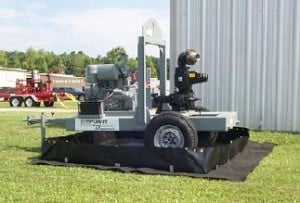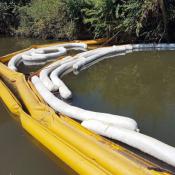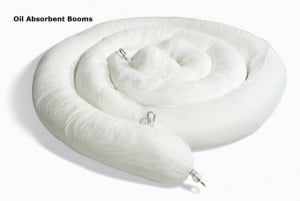Know How to Pick the Best Spill Control and Containment Product for Emergency Response
When it comes to spill containment, some people assume that “booms” and “berms” are the same. Both are highly effective tools for containing oil and other hazardous chemical spills. However, their overall designs and appearance are quite different. As are the ways in which you use them for spill response.
Do you own or manage a company that deals with oil or hazardous chemicals? Then, it’s important to educate yourself on the functions of a spill boom versus a berm.
While they share some similarities, when it comes to spill control they have significant differences. We’ll cover some of those key variations, characteristics, and features in this post.
Containment Berms
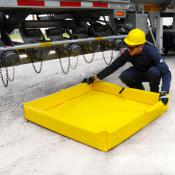
Portable berms typically require minimal assembly. They act as miniature swimming pools to hold liquid spills
A containment berm is a basin-like structure that you use in the event of a chemical spill. You place it beneath the source of the chemical leak for quick and easy containment. For instance, if a forklift is leaking oil or battery acid, you’ll assemble a berm below to catch it. In that way, it acts like a miniature swimming pool to collect the spilled liquid. Much like a larger version of a PVC lab or utility tray.
There are several kinds of containment berms available, with different types of setups, capacities, and uses. For example, portable berms are small and easily maneuverable—just as the name suggests. These versatile berms are quick to assemble under the source of a leak for instant containment.
There are also “assembly” and “no-assembly required” containment berms. In the case of no-assembly models, you simply unpack or unroll the berm for quick deployment. They typically feature tough PVC or copolymer materials and have foam or self-rise floatation walls. Both kinds protect against leaks with everything from storing IBCs to parking large vehicles like tanker trucks.
It’s not a bad idea for companies to acquire several different types of berms. This not only helps offer protection against a variety of chemical spills but also different use situations.
Containment Booms
A containment boom differs from a berm in the sense that it doesn’t have a bottom. You place a boom directly over or around a spill to contain and/or absorb it.
It’s important to note that there are two types of booms. Containment booms are designed specifically for containing oil in a given area. Whereas absorbent booms work to actually clean the oil or chemical from the water’s surface.
One of the benefits of using a boom is its simplicity. These large rolls are set up to create a perimeter that surrounds a spill. And since oil is less dense than water, it floats to the surface where it can’t escape.
Back when the Deep Water Horizon Oil Spill took place in the Gulf of Mexico, containment booms played a key role. And saw thousands of people participating in the cleanup efforts both at sea and on land. Rapid response booms were able to help contain the oil, limiting the spill spread and environmental damage.
Non-absorbent containment booms
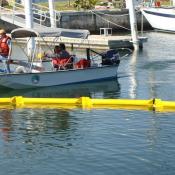
Containment booms link together with connectors. Flotation chambers provide buoyancy on water
Non-absorbing spill containment booms act as temporary floating barriers. Meaning that they create a floatation wall around an oil slick on the water to confine it. This is why they are sometimes known as fence booms. And are often in use with skimmer equipment that recovers the oil spill from the water surface.
Heavy-duty metal connectors join boom sections together into necessary lengths. As the name suggests, inflatable booms use air chambers for buoyancy. Others have flotation chambers with lightweight foam-type tubes inside. Some models wind onto boom reels for easy storage and transportation. For more details, check out our previous post on how oil booms work.
Booms come in different designs that are specific to water conditions. For instance, in calm waters, the Economax boom is a great choice. It has a 6″ freeboard above water that creates the temporary floating barrier wall. Which makes it ideal to contain hydrocarbons like oil as well as general debris.
In coastal and marine areas you’ll need a more heavy-duty design for fast waters. The Simplex oil boom is suitable for shoreline and coastal areas, with a 6″ freeboard for stable floatation.
For long-term use in rivers, harbors, and other fast-water zones, the Optimax I or II models are great choices. They have galvanized chains and heavy-duty connectors for high tensile strength and towing. This means they are popular with coast guards, oil spill responders, and other emergency response teams.
Absorbent booms
Like containment booms, you link absorbent booms together to create the necessary perimeter size. Their tube shape and function is similar to an oversize absorbent sock that’s commonly found in spill kits.
Absorbent booms come in different colors depending on the spill type and where you plan to use them.
- Yellow booms are for absorbing chemical or hazmat spills. They are suitable for use on land only because they do not float.
- Likewise, grey absorbent booms will not float and are for land spills only. Their grey color indicates they are for universal spill applications. Which means they will soak up water as well as oils.
- Whereas white oil spill containment booms will float on water. And are for absorbing various types of hydrocarbons, including gasoline or diesel fuels. They make great partners to non-absorbing containment booms to help contain and remove oil from water.
Your oil spill response and absorbent experts
AbsorbentsOnline is your go-to supplier of affordable spill response booms and more. We offer a wide range of spill kits, pallets, absorbents, and other clean-up supplies.
 Questions about oil spill containment booms for your business? Get in touch with Travis Zdrazil at travis@absorbentsonline.com or (800) 869-9633.
Questions about oil spill containment booms for your business? Get in touch with Travis Zdrazil at travis@absorbentsonline.com or (800) 869-9633.
This is a revision to a blog post with an original publication date of December 16, 2013
